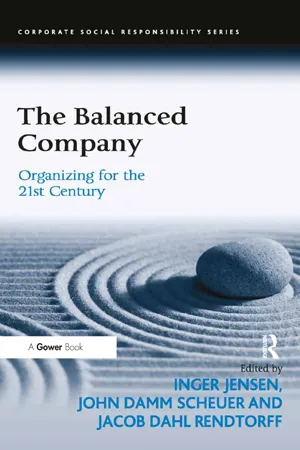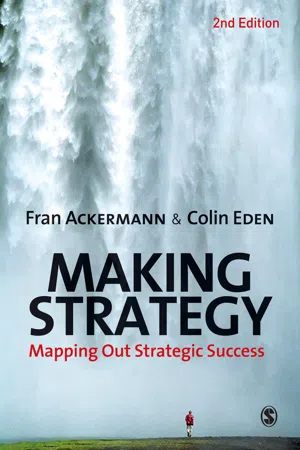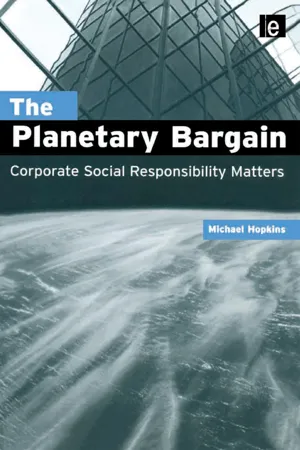Business
Stakeholder
Stakeholders are individuals or groups who have an interest in the activities and outcomes of a business. They can include employees, customers, suppliers, shareholders, and the local community. Understanding and managing the needs and expectations of stakeholders is crucial for the success and sustainability of a business.
Written by Perlego with AI-assistance
Related key terms
Related key terms
1 of 4
Related key terms
1 of 3
12 Key excerpts on "Stakeholder"
- eBook - ePub
Cosmopolitan Business Ethics
Towards a Global Ethos of Management
- Jacob Dahl Rendtorff(Author)
- 2017(Publication Date)
- Routledge(Publisher)
Freeman’s ten principles clearly show how Stakeholder theory can be considered as a network-based, communicatively oriented theory, working at placing the company in a social context, and this approach aims to promote both individual interests and the concern for the community without sacrificing the profit-oriented business economic foundation of corporations. In this regard, we can distinguish between: (1) voluntary versus involuntary Stakeholders, such as owners versus non-owners; (2) primary Stakeholders (those who have direct and effective links with the company, e.g. owners or employees) and secondary Stakeholders (whose relationship with the company is more peripheral, such as occasional customers). This is closely related to the distinction between internal and external Stakeholders, such as employees or customers.Figure 12.1 The responsibilities of business for society: the different Stakeholders in the community.Thus, we can propose a limited definition of the relevant Stakeholders in an organization that can be used to distinguish the importance of the company’s various Stakeholders. From this perspective we can define a Stakeholder as: (1) any group or person who is indispensable for the organization’s survival, success, and prosperity, or (2) is important for the definition of the organization, its mission and purpose, and affects or is affected by the organization and its activities. Stakeholders occupy differing roles and positions within and outside the company (Mitchell, Agle, and Wood 1997).However, the question of the definition of Stakeholder status in relation to reflections on corporate ethics and social responsibility becomes more complicated when we analyze the various dimensions of Stakeholder status. The problem is whether one can distinguish between instrumental, normative, and descriptive elements of Stakeholder theories when relevant Stakeholders must be identified (Donaldson and Preston 1995).Instrumental Stakeholder theory is not necessarily beyond the traditional business model, but considers the company’s interest in maximizing profits as the basis for the analysis (Jones 1995). Descriptive Stakeholder theory is content with identifying groups or individuals that can actually be described as Stakeholders from the applicable border definitions without making any ethical prioritization of these Stakeholders. The normative theory, however, goes further to include in addition to the description of actual Stakeholders the question why certain people or groups must be taken into account by the company with a focus on CSR and corporate governance. The normative theory also seeks to answer the question about who from an ethical point of view basically can be counted as Stakeholders of the firm (Mitchell, Agle, and Wood 1997). - eBook - ePub
The Balanced Company
Organizing for the 21st Century
- Inger Jensen, John Damm Scheuer(Authors)
- 2016(Publication Date)
- Routledge(Publisher)
The literature offers many other principles with more or less justified grounds. Besides the utilitarian principle (maximizing the sum of utilities) we can indiscriminately appoint the Nash principle (multiplying the product of utilities), the equalitarian principle (equal utility to all), and the Rawls principle (maximizing the utility of the most unfortunate). No need to expect that unanimity will be reached.The Balanced Company
The aim of this section22 is to attempt to mark out guidelines for a formalization of the balanced company. An essential element of a more precise conception is, obviously, the Stakeholder. This chapter identifies the Stakeholder approach with the balanced company.StakeholderS
For several years, in the 1960s and early 1970s, one of the founders of the behavioral theory of the firm was a regular guest lecturer at the Copenhagen Business School.23 Since then, the Stakeholder model has been firmly installed in business economics taught to Danish students.The figure is well known and self-explanatory. It shows some of the Stakeholders to whom the company is supposed to be responsible. According to Freeman (1984: 46): “A Stakeholder is any group or individual who can affect or is affected by the achievements of the organization’s objectives.”According to, among others, Jensen (2001), this is a broad definition that includes too many actors, such as the company’s competitors and different types of criminals. A series of typologies have been developed that resemble Freeman’s definition. The figure makes an important distinction between insiders and outsiders, one of the reasons for governance problems. Clarkson (1995: 106) divides Stakeholders into two categories: “a primary Stakeholder group is one without whose continuing participation the corporation cannot survive as a going concern,” while the secondary groups are “those who influence or affect, or are influenced or affected by the corporation, but they are not engaged in transactions with the cooperation and are not essential for its survival.” Following Clarkson, the primary group includes shareholders, employees, customers, suppliers, as well as public Stakeholders like government and other providers of infrastructures and market places “whose laws and regulations must be obeyed, and to whom taxes and obligations may be due.” - eBook - ePub
Unfolding Stakeholder Thinking
Theory, Responsibility and Engagement
- Jörg Andriof, Sandra Waddock, Bryan Husted, Sandra Sutherland Rahman(Authors)
- 2017(Publication Date)
- Routledge(Publisher)
et al . 2002) are evidence of a movement towards theory that explains how organisations function with respect to various constituencies with whom they are inextricably embedded.Stakeholder theory development has centred on two related streams: (1) defining the Stakeholder concept and (2) classifying Stakeholders into categories that provide an understanding of individual Stakeholder relationships. One of the primary challenges in Stakeholder analysis has been the construction of a universally accepted definition of the term ‘stake’ (Donaldson 1995). Starik (1994) notes that, although there has been an abundance of articles and books using Stakeholder thinking, the meaning of the term ‘Stakeholder’ has not been consistently applied. Freeman’s definition of Stakeholder— ‘any group or individual who can affect or who is affected by the achievement of the firm’s objectives’ (1984: 25)—continues to provide the boundaries of what constitutes a stake.Although debate continues over whether to broaden or narrow the definition, most researchers have utilised a variation of Freeman’s concept. For example Hill and Jones define Stakeholders as ‘constituents who have a legitimate claim on the firm’ (1992: 133). Carroll (1993) also argues that those groups or individuals can be Stakeholders by virtue of their legitimacy, but he broadens the scope of the definition to include those who have power—the ability to impact the organisation. Clarkson (1995) suggests an alternative approach for identifying and evaluating Stakeholder claims, which casts Stakeholders more narrowly as risk-bearers. He argues that a Stakeholder has some form of capital, either financial or human, at risk and, therefore, has something to lose or gain depending on a firm’s behaviour. To these elements, Waddock (2002) adds a tie or tether that creates a bond of some sort.Regardless of how Freeman’s (1984) definition is modified, there is a core idea that underlies the unfolding of Stakeholder thinking. Whatever the definition within the Stakeholder perspective, organisations are required to address a set of Stakeholder expectations and, increasingly, they find themselves engaged with Stakeholder groups or their representatives in various ways as part of the process to meet these expectations. Thus, management choice is a function of Stakeholder influences (Brenner and Cochran 1991; Mitchell et al - eBook - ePub
Making Strategy
Mapping Out Strategic Success
- Fran Ackermann, Colin Eden(Authors)
- 2011(Publication Date)
- SAGE Publications Ltd(Publisher)
Furthermore, not all Stakeholders are of equal importance and so it is essential to focus energy on the management of those that are most important – the key Stakeholders. Gaining a deeper understanding of the Stakeholder’s power for, as well as interest in, influencing the direction of the organisation can be used as two significant dimensions of analysis for assisting this prioritisation process. From this examination of power and interest it is possible to determine when it is appropriate to develop or alter the bases of an individual Stakeholder’s significance.WHO ARE THE StakeholderS?6
Stakeholders are those who have a stake in the future success or failure of the organisation – those who can deliberately ‘make’, ‘break’ or ‘shake’ the success of any strategic action. However, in developing successful strategy we must also consider those who, without deliberate or designed actions to support or sabotage, can also affect significantly the future of the organisation – these also need to be managed. Thus, we are interested in those who have the power to affect what happens – they can take actions that will affect the success of our strategic actions. We are also interested in those who have a stake in the situation – they will approve of some possible outcomes more than others.In some of the earliest work on Stakeholders an internal memorandum at the Stanford Research Institute conceptualised Stakeholders as ‘those groups without whose support the organisation would cease to exist’. However, other researchers suggest including as Stakeholders those groups or individuals who are affected by the organisation as well as those who can affect it. Thus, who are Stakeholders is related to the multifarious nature of the demands - eBook - ePub
- Michelle Gledhill(Author)
- 2012(Publication Date)
- Routledge(Publisher)
UNIT 1 The Importance of StakeholdersLearning outcomes Assess the relative importance of organizational Stakeholders on the marketing function and the impact they have on the organization’s marketing activities.Syllabus ContentRELATIONSHIPS BETWEEN ORGANIZATIONS1.1Assess the different categories of relationships that exist between organizations.1.2Assess the relative importance of the different Stakeholder groups and consider the nature of Stakeholder relationships and their influence and impact on the organization.1.3Explain the nature of the interactions between the organization and its different Stakeholders groups.1.4Explain the significance of the range of pressure groups as key Stakeholders interested in the organization and their potential impacts upon market-oriented organizations.1.5Specify the role of marketing in managing these pressure groups effectively.1.6Evaluate the different options to developing a relationship management (RM) approach within a market-oriented organization.DEFINITION Stakeholders are defined as:As such we can consider Stakeholders to be people and organizations who have a say in the following:Those persons and organizations that have an interest in the strategy of the organization. Stakeholders normally include shareholders, customers, staff and the local community. (CIMA)What you are to doWhat resources you haveWhat you should achieve.They are affected by, and feel they have a right to benefit or be pleased by, what you do.It is important to remember that if an organization tries to implement strategies which are in conflict with the interests of powerful Stakeholders those strategies are highly likely to fail. This does mean, however, that if powerful Stakeholders agree with what we are trying to do it will greatly improve our chances of success.With that in mind, it is important for an organization to identify its Stakeholders and their power to affect the decisions and outcomes. Within this process it is worth noting that Stakeholder values may not be immediately apparent, and it is important to distinguish between desired, stated and lived values. - eBook - ePub
Transforming Enterprise?
American Evangelicalism, Capitalism, and the Challenge of Practical Theology
- Andrew Yancey(Author)
- 2020(Publication Date)
- Pickwick Publications(Publisher)
Like the theme of transformation, the emergence of Stakeholder theory in the late twentieth century was not in a vacuum. Significant shifts were taking place in perceptions about the role of capitalistic enterprise in shaping human experience, prompting debates over the ways in which the financial and operational dimensions of a firm should determine its broader social functioning. In overviewing Stakeholder theory, I first describe the Stakeholder framework in relation to these debates. Then, I show how Stakeholder’s ethical framework has primarily depended on relational individualism, similar to the individualist model adopted by secularization theory.The Stakeholder FrameworkStakeholder theory holds that the purpose of a firm is to maximize long term value for all its Stakeholders. A Stakeholder is “any group or individual who can affect or is affected by the achievement of the organization’s objectives.”349 They are the groups without whose support the organization would cease to exist and include not just shareholders, but employees, customers, suppliers, society, government, and the environment.350 It emerged in the late twentieth century in response to shareholder theory, which contended that the only responsibility of a firm is to maximize shareholder profits without violating any laws.Conceptually, Stakeholder theory is an effort to address three interconnected business problems: how value is created and traded, how ethics is connected to profit, and how to help managers think about management such that the first two are addressed.351 An important conviction is that these problems are more effectively addressed with integrative vocabulary that captures the complex relationships between firms and their constituencies. A business can be seen through a financial lens as an income statement and balance sheet; through an operational lens as a supply chain or a distribution channel; through a customer lens as a product or service to be bought, and through a social/relational lens as a set of relationships among groups that have vested interest in its objectives and activities.352 How executives and managers govern the interests of its various Stakeholders determines the long-term success of the enterprise.These ideas might seem obvious because Stakeholder language has become so pervasive. However, that was not always the case. Modern business management evolved in the early twentieth century with stress on productivity and output. Frederick Taylor, an engineer by trade, provided one of the first management theories. The innovation of Taylor’s system was the idea that efficiency could be enhanced by analyzing workflows.353 He challenged the prevailing assumption that an increase in the intensity of a laborer’s work automatically equaled an increase in economic value. Using several time and motion studies, Taylor argued that the focus of management should be on an optimization of the workflow process. Thus, Taylor argued for a management bureaucracy in an organization that was devoted to training employees and controlling outputs.354 - eBook - ePub
- Pernille Eskerod, PhD, MSc, Martina Huemann(Authors)
- 2016(Publication Date)
- Project Management Institute(Publisher)
Strategic Management: A Stakeholder Approach (1984). In this book, Freeman suggested turning management's attention away from a pure stockholder/shareholder approach, and instead, having management consider more parties in the (strategic) management approach (Freeman et al., 2010; Hasnas, 2013). Even though earlier research touched upon core elements of Stakeholder thinking (e.g., see Abrams, 1954; Ackoff, 1970; Ackoff, 1974; Ansoff, 1965; Cyert & March, 1963; and Rhenman, 1968), Freeman's book is widely considered to be the starting point for an academic interest in Stakeholder theory (e.g., Hasnas, 2013), as since 1984, Stakeholder theory has received considerable attention in academia, resulting in a large number of academic publications (for a review, see Freeman et al., 2010; Friedman & Miles, 2006; and Laplume, Sonpar, & Litz, 2008).The original contribution of Freeman was that he criticized strategic management for only considering shareholders and not paying attention to other parties. He offered an inclusive definition of Stakeholders as “any group or individual who can affect or is affected by the achievement of the organization's objectives” (Freeman, 1984, p. 46). Examples of Stakeholders are persons, groups, neighborhoods, organizations, institutions, societies, and the natural environment (Mitchell, Agle, & Wood, 1997). Since Freeman's definition, which remains very much in use, numerous Stakeholder definitions have evolved.Stakeholders are voluntary or involuntary risk-bearers: “Voluntary Stakeholders bear some form of risk as a result of having invested some form of capital, human or financial, or something of value, in a firm. Involuntary Stakeholders are placed at risk because of the result of a firm's activities. But without the element of risk, there is no stake” (Clarkson, 1994, p. 5). Therefore, Alkhafaji (1989) stresses the responsibility of companies toward their Stakeholders. - eBook - ePub
Convincing Political Stakeholders
Successful Lobbying Through Process Competence in the Complex Decision-making System of the European Union
- Klemens Joos(Author)
- 2023(Publication Date)
- Wiley-VCH(Publisher)
Figure 2.2 ). Accordingly, the theory developments in this initial stage are based on this preliminary theoretical work.Freeman (1984) points out that the term Stakeholder probably occurred first in 1963 in an internal memorandum at the Stanford Research Institute (SRI), where it was originally defined as “those groups without whose support the organization would cease to exist”.49 As explained above, Freeman extends this term to include all individual persons and groups which can influence the achievement of an organisation's goals, or which are affected by the achievement of an organisation's goals. The latter also refers to Stakeholders who may be affected in the future. The strategic and integrative orientation of his approach is revealed in the following quotation:“Groups which 20 years ago had no effect on the actions of the firm, can affect it today, largely because of the actions of the firm which ignored the effects on the groups. Thus, by calling those affected groups ‘Stakeholders’, the ensuing strategic management model will be sensitive to future change, and able to turn new ‘external changes’ into internal changes. One way to understand the definition is to think of the Stakeholder concept as an umbrella for the problems in business strategy and corporate social responsiveness. To be an effective strategist you must deal with those groups that can affect you, while to be responsive (and effective in the long run) you must deal with those groups that you can affect.”50 - eBook - ePub
The Planetary Bargain
Corporate Social Responsibility Matters
- Michael Hopkins(Author)
- 2012(Publication Date)
- Routledge(Publisher)
Chapter 3
The Seven Azimuths: Who Are the Stakeholders?
Introduction
The word ‘Stakeholder’ conjures up images of early gold rushers bashing bits of wood into the ground to establish their claim. It is an ugly word but one, nevertheless, that has passed into common usage among the growing community concerned with corporate social responsibility (CSR). There is no general agreement on who or what are the Stakeholders of a firm, and Stakeholder theory offers ‘a maddening variety of signals on how questions of Stakeholder identification might be answered.’1 Anne Svendsen has come up with a useful and practical, if uncritical, look at the application of Stakeholder strategy to corporations.2 She traces, conceptually, the evolution of corporate Stakeholder theory from what was once a defensive style, where managers paid lip-service to its Stakeholders en route to making a profit, to a lukewarm interest, especially in customers as essential to make a profit in today’s collaborative and ‘systems’ approach – where interactions with Stakeholders provide a win–win situation.Whatever theory eventually emerges, practice has shown that in terms of social responsibility there are at least seven azimuths, communities or Stakeholders that the business spectrum is involved with – namely:31 owners/investors (shareholders or stockholders); 2 management; 3 employees; 4 customers; 5 the natural environment; 6 the wider community (including government); and 7 contractors/suppliers.What is the social responsibility of the company to each group and what, in turn, are the responsibilities of each group to the company? These are the questions that are explored in this chapter.Owners and investors
As will be noted in Chapter 4 , it is not, generally, owners and investors acting as shareholders or stockholders that companies generally address, either in terms of ethics or in terms of their responsibilities to them, other than that of making a profit. Increasingly, shareholders are asking questions about business practices. For instance, in 1995, developing-world debt campaigners in the UK started buying single shares in Lloyds Bank so as to be able to attend the company’s annual meetings.4 At the bank’s meeting that November, both male and female protestors removed their clothes to reveal anti-debt slogans on their bodies. This was meat and drink for the UK’s tabloid press, who gave unprecedented coverage to the issue of debt forgiveness. Five months later, a more measured approach by church-based anti-smoking campaigners in the US won such significant support from pension-fund shareholders that they almost forced the board of RJR Nabisco at its annual general meeting (AGM) to split the food and tobacco multinational into separate parts.5 - eBook - ePub
- Derina Holtzhausen, Jami Fullerton, Bobbi Kay Lewis, Danny Shipka(Authors)
- 2021(Publication Date)
- Routledge(Publisher)
Stakeholders can be divided into internal and external groups. Internal groups are within the organization and include employees, managers and owners. External Stakeholders are outside of the organization. External Stakeholders include customers, investors, supplier/partners, society, government and even creditors.Figure 8.1 Internal and External StakeholdersStakeholders also can be categorized according to the amount of involvement they have. Primary Stakeholders are impacted directly—positively or negatively—by the actions of the organization, while secondary Stakeholders are affected indirectly. Key Stakeholders may not be affected at all, but still have a significant ability to influence the organization, such as a regulatory body or government agency. Identifying the primary, secondary and key Stakeholders is necessary to a successful strategic communication campaign.Stakeholder Groups
Another way to identify Stakeholders is to analyze how they are linked to your organization. Communication scholars Grunig and Hunt1 established that four main linkages exist—enabling, functional, diffused and normative. To understand this concept, it might help to think about your university. A university is a complex system that affects thousands of people. These people can be placed in different Stakeholder groups by the way they are linked to a specific university. For example, Congress, State Legislators and the Board of Regents are all linked to the university in the same way—they enable it to operate through funding, regulations and guidance. These groups have some level of control over the organization. If the organization’s relationship with these groups runs into problems, resources might become scarce. These Stakeholder groups are enabling the organization to exist.Faculty, staff and other employees are another Stakeholder group that help the university function on a daily basis. By giving their input (i.e. time, energy and knowledge), they create the products and services (such as your education) that the university offers. This Stakeholder group is typically highly invested in the success of the organization—what happens within the organization will affect them directly. Students, such as yourself, are another functional Stakeholder group in your university. You consume the university’s output—in this case your education—which directly affects you. - eBook - ePub
The Stakeholder Strategy
Profiting from Collaborative Business Relationships
- Ann Svendsen(Author)
- 1998(Publication Date)
- Berrett-Koehler Publishers(Publisher)
chapter 3 was the notion that corporate strategy, among other things, defines how a company manages its explicit and implicit contracts with Stakeholders. It defines what the company expects to receive from its Stakeholder relationships and what it is prepared to give. This Stakeholder-oriented view of strategy differs sharply from the traditional view that strategic plans should focus mostly on financial goals and initiatives designed to improve financial performance.A Stakeholder-oriented approach to corporate strategy makes more sense today than in the past because companies depend more on their Stakeholder relationships to ensure financial success. To ensure long-term success, a company must manage the increasingly important intangibles that drive financial performance, like employee know-how, the quality of relationships with suppliers, customer satisfaction, and corporate reputation. Today more than 60 percent of a company’s value is tied up with intangibles rather than hard assets like machinery or land.1 This figure rises even higher in knowledge-based industries.A recent study involving five of Canada’s largest and most progressive companies indicates that a Stakeholder-oriented approach to corporate strategy-making is becoming more common. All five companies included a broad array of Stakeholders in their strategic plans. For instance, at Nova Corporation, an integrated natural gas services and petrochemicals company headquartered in Calgary, Alberta, strategy focuses on four key Stakeholder groups: shareholders, customers, employees, and communities. Senior management and members of the board of directors believe that to fulfill the company’s vision and achieve long-term profitability, employees and management must excel at meeting the needs of these groups. Over the long term, they believe that financial results are driven by superior performance for customers, employees, and the community. Accordingly, the company’s strategy includes specific goals for each Stakeholder group including the following:112 - John McManus(Author)
- 2007(Publication Date)
- Routledge(Publisher)
Marty individuals or institutions may be indirectly involved or affected because of their technical expertise or public and private interest in organizational policies or programs, or they may be linked in some way to those who are directly affected. Such Stakeholders may include various intermediary or representative organizations, private sector businesses, and technical and professional bodies. For project managers identifying and enlisting the right intermediary groups can and does prove difficult at times and in some situations can turn out to be a process of trial and error.Figure 2.4 Stakeholder classifications.With primary, secondary, and external Stakeholders there is a managing of interests; these Stakeholders and their interests "must be dealt with" so that the project organization may achieve its goals. With extended Stakeholders we seek some balancing of interests. Here, the Stakeholder and ethics literatures intersect and gives a more bidirectional account of the project organization and its Stakeholders. Figure 2.4 categorizes the types of Stakeholders groups within a broad project community.2.2.1 Primary Stakeholders
Primary Stakeholders include those who, because of power, authority, responsibilities, or claims over the resources, are central to any project initiative. As the outcome of any action will affect them directly, their participation is critical. Primary Stakeholders can include private sector interests, and local and national government agencies.This category of Stakeholder also includes, by virtue of the power they wield, those who have the capacity to influence collaboration outcomes, but who may not themselves be directly affected by them. This group can include politicians and officials at the local, national, and regional levels, and international agencies who control policies, laws, or funding resources. Failure to involve primary Stakeholders in collaboration efforts from the start can lead to subsequent implementation, technical, or political difficulties in achieving project objectives.2.2.2 Secondary Stakeholders
Secondary Stakeholders are those with an indirect interest in the outcome. Depending on the issue, secondary Stakeholders may, for example, be the consumer (who is interested in the continuing availability of a product or service), the company employee (who is concerned about job security). These Stakeholders may need to be involved in collaboration processes, but their role may be peripheral to that of primary Stakeholders, so they may need to be involved only periodically. Secondary Stakeholders may need to have a role, for example, in identifying the costs and benefits of their interests or products, yet they may not need to be involved in all aspects of project initiatives. Project managers of collaboration projects need to plan when and how to include both primary and secondary Stakeholders, as well as to monitor changes in their interests and influence.
Index pages curate the most relevant extracts from our library of academic textbooks. They’ve been created using an in-house natural language model (NLM), each adding context and meaning to key research topics.
Explore more topic indexes
Explore more topic indexes
1 of 6
Explore more topic indexes
1 of 4











